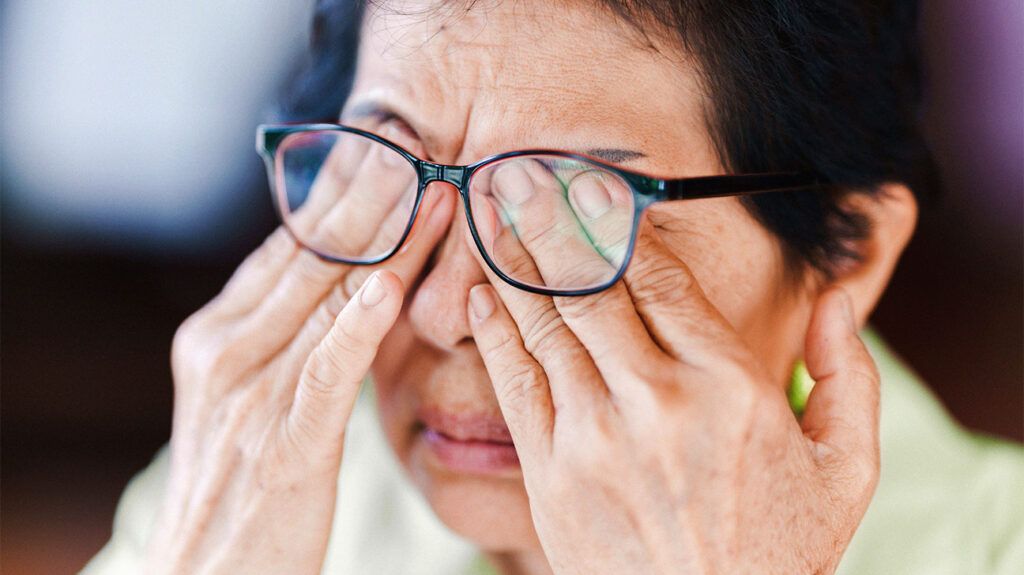Although rare, people might experience vision problems after COVID-19. These might involve the effects of COVID-related blood clots that travel to the eye, causing blockages, inflammation, and cell death.
COVID-19 is a respiratory disease that develops after a person contracts a virus called SARS-CoV-2. It is highly contagious and may cause coughing, loss of taste and smell, and breathlessness. The effects of COVID-19 can last for at least 3 months beyond the typical duration of the disease in a chronic condition known as long COVID.
While COVID-19’s respiratory symptoms are well-known, the virus and its chronic form might also cause symptoms in the heart, joints, muscles, and digestive system. Some people have also reported vision changes following COVID-19.
Coronavirus data
All data and statistics are based on publicly available data at the time of publication. Some information may be out of date. Visit our coronavirus hub for the most recent information on COVID-19.

At first, researchers mainly focused on how SARS-CoV-2 could transmit directly into the eye through
However, a 2024 study on mice found that SARS-CoV-2 might trigger excessive inflammation in the eye. This can destroy cells in the barrier between the cells that line the back of the eye, known as the retina, and the blood. If remnants of destroyed SARS-CoV-2 viruses remain in the eye, this may lead to cell death in the retina.
According to the American Academy of Ophthalmology, COVID-19 vision problems may occur within 1 to 6 weeks of noticing COVID-19 symptoms. Increased inflammation throughout the body can cause blood clots to form. These may travel to the retina and cause blockages and the following vision problems:
- Cotton wool spots: Blood clots can block nutrients from reaching the retina, meaning that its tissue may swell up and die. When an eye doctor performs an optical coherence tomography (OCT) exam, the final scan may show cloud-like, white blemishes. These cotton wool spots do not usually cause vision problems.
- Retinal artery occlusion: Some doctors refer to this as an eye stroke. It occurs when a clot blocks the retina’s oxygen supply, leading to cell death. The most common symptom is sudden vision loss, but the condition does not cause pain.
- Retinal vein occlusion (RVO): After COVID-19, a blood clot can block blood flow away from the eye. Also known as a retinal vascular occlusion, this can cause a buildup of blood, increasing pressure and contributing to a person’s risk of swelling, bleeding, and leaks. The pressure increase can cause blurred vision and sudden blindness that might become permanent.
- Retinal hemorrhage: This describes bleeding in the retina. Blood vessels may sometimes start leaking after an RVO. This can cause blind spots and either sudden or gradual vision loss.
- Uveitis: A
2024 observational study found that the virus, immune system, and resulting inflammation may increase inflammation in the eye, leading to uveitis. This type of inflammation can lead to blurry vision, floaters, red eyes, and increased light sensitivity. Without treatment,vision loss may develop . - Conjunctivitis: Also known as pink eye, this ocular condition can occur due to viral infections. A
2024 article notes that a potential ocular presentation of COVID-19 can include conjunctivitis. - Optic neuritis: This refers to the inflammation of the optic nerve that connects the eye to the brain. It can be a
rare complication after COVID-19 . Optic neuritis may lead to vision loss, swelling of the optic nerve, and pain in the affected eye.
Around
- eye pain
- restricted vision
- a feeling of something in the eye
- a reduced ability to read text or look at a screen for long periods
- increased light sensitivity
The authors linked these symptoms to increased inflammation and changes in nerve function. However, the study was small, and eye symptoms are
The
A
- 2,229 (around 33.3%) reported eyelid swelling, conjunctivitis, and an atypically higher blood flow in the eye.
- 1,785 (around 26.7%) reported blurred vision.
- 1,322 (around 19.7%) reported visual impairment.
These occurred most often after the Moderna and Janssen vaccines, while over 73% of the reports occurred in females.
However, it is worth noting that these complications were rare, were not permanent, and did not result in long-lasting damage to vision.
COVID-19 has a very low risk of eye problems. However, people with certain underlying conditions have a higher risk of post-COVID eye complications, including:
- diabetes
- high blood pressure
- blood disorders
- blood vessel issues
The severity of COVID-19 symptoms does not seem to affect a person’s risk of eye complications. Reports have suggested that they have developed in both those who had severe COVID-19 symptoms and those who had no symptoms at all.
The best way to prevent eye complications of COVID-19 is to reduce the risk of acquiring the virus. This might involve:
- wearing a face mask when around others
- thoroughly and regularly washing and sanitizing the hands
- receiving COVID-19 vaccinations
Rarely, COVID-19 can cause vision problems by increasing a person’s risk of blood clots. These may develop due to increased inflammation after the immune system has attempted to manage the virus. Possible vision complications include cotton wool spots, retinal artery occlusion, retinal vein occlusion, retinal hemorrhage, uveitis, and optic neuritis.
People with diabetes, high blood pressure, and blood vessel and blood disorders might have an increased risk of eye problems after COVID-19. Long COVID and COVID-19 vaccinations might also carry a very low risk of vision problems. Handwashing, vaccination, and wearing a mask around others can reduce the risk of COVID-19 and its complications.
